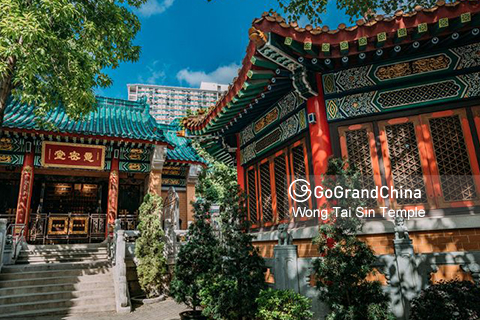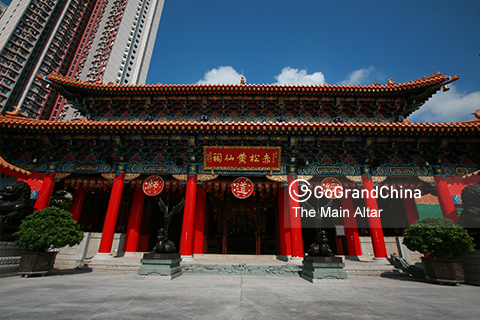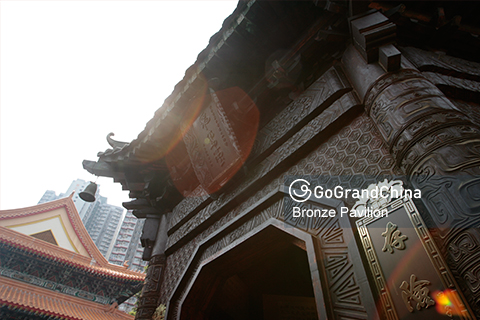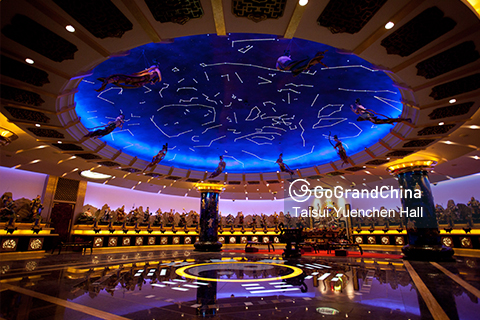You have no items in your shopping cart.
Wong Tai Sin Temple
Introducing Wong Tai Sin Temple (from Hong Kong Tourism Board & official website)
The Wong Tai Sin Temple's claim to "make every wish come true upon request" might have something to do with its popularity. Home to three religions (Taoism, Buddhism and Confucianism) its natural setting and beautifully ornamented buildings make Wong Tai Sin Temple as much a scenic attraction as an important religious centre in Hong Kong. The temple commemorates the famous monk of yore, Wong Tai Sin (also known as Huang Chu-ping), who was born in the 4th century and became a deity at Heng Shan (Red Pine Hill). In 1915, Taoist priest Liang Ren-an carried a sacred portrait of Wong Tai Sin from Guangdong in southern China to Hong Kong. Now housing this precious portrait, the Wong Tai Sin Temple is where worshippers pray for good fortune through offerings, divine guidance and fortune telling.
Wong Tai Sin Temple Fast Facts
• Chinese Name: Huang Da Xian Ci 黄大仙祠
• Best Time to Visit: September to February
• Recommended Visiting Hours: 1-2 hours
• Things to Do: Photography, Religious Study
• Opening Hours: 07:30-16:30 for Temple; 08:00-16:30 for General Office, Good Wish Garden & Taisui Yuenchen Hall
• Entrance Fee: Free
• Address: 2, Chuk Yuen Village, Wong Tai Sin, Kowloon, Hong Kong
What to expect at Wong Tai Sin Temple
The architecture of Wong Tai Sin Temple is based on the Five Elements, that is, the Bronze Pavilion representing “Metal”, the Archives Hall representing “Wood”, the Yuk Yik Fountain representing “Water”, the Yue Heung Shrine representing “Fire”, and the Earth Wall representing “Earth” – all five elements have been incorporated. Other areas of the complex include the Three Saints Hall, the Confucian Hall and the extravagantly colourful Good Wish Garden that is lavishly decorated with chinoiserie.
The Main Altar
The Main Altar was built in 1921, with a horizontal plaque of the inscription “Chisong Wong Sin Ci” on the top of the main entrance, is mainly for worshipping and presenting offerings to Master Wong Tai Sin. The Altar was refurbished significantly from 2008 to 2010. The sacred portrait of Master Wong Tai Sin was housed at the precious throne in the middle of the Altar. Biography of the Great Master was also engraved as “Tai Sin’s Eight Phases to Enlightenment” at the back. Master Wong Tai Sin was originally known as Wong Cho-ping and his immortal title is Chisong Fairy. He was born in the Eastern Jin Dynasty in 328 AD and his family was very poor in his childhood. He was only 8 years old when he herded sheep at Jinhua Mountain, north of Jinhua in Zhejiang Province. At the age of 15, he received an advice from an immortal to practise the Tao in a stone cave in the mountains. His elder brother Wong Cho-hei had never given up looking for him everywhere ever since he was missing. After some forty years, the two brothers finally reunited. When Wong Cho-hei asked Master Wong the whereabouts of his sheep herd, the Master led him to a heap of white boulders on the east side of the mountain. The Master suddenly yelled at the white boulders. Miraculously, the rocks started to move and turned into a flock of sheep. As the Master attained the Tao on Chisong Mountain, thus he was also known as Chisong Wong Tai Sin. Wooden paintings and scriptures of Taoism, Buddhism and Confucianism are hung on the wall as decoration. The left of the Altar enshrines the Monkey King, the Master’s guardian deity as advised by the divine writing. A pair of bronze Forbidden City lion replicas, huge stone sculpture of a “Qilin Du” and a pair of bronze crane-tortoise are placed outside the Altar solemnly. All these mythological decorations have made the Main Altar exceptionally sacred and elegant. Our temple celebrates the birth of Master Wong Tai Sin on the 23rd day of the 8th month of the Lunar Calendar and celebrates the birth of Monkey King on the 16th day of the 8th month.


Bronze Pavilion
First built in 1924, it is believed to be the altar for early spirit writing and Master Wong Tai Sin’s meditation room. Besides enshrining Master Wong Tai Sin, the Bronze Pavilion also houses Zi Yang De Tao Qi Shan Pu Sa. In addition, the calligraphy of the Scripture of Master Wong Tai Sin is hanging on the edges of the ceiling. A pair of couplets are on both sides of the entrance reads. Both the calligraphy and couplets are inspirational.
Archives Hall (General Office)
Also where the General Office of Sik Sik Yuen is located, the Archives Hall was first built in 1924 and renovated in 1936 and 1981. Its appearance resembles those traditional Chinese temples, with its interior being a two-storey wood structure, representing Wood of the Five Elements. Inside, one can find the ceramic photos of philanthropists who made significant donations to Sik Sik Yuen. The daily administrative work of the organization takes place here as well. The recent interior renovation has injected a strong sense of refreshment to the Hall.
Yuk Yik Fountain
Representing Water of the Five Elements, it is a circular fountain in front of the Archives Hall. The 1936 Fountain was made from bricks patterned in cross, while in 1961 it became a spherical sprinkling flower wreath. The 1993 design comprised seven lotuses, representing the Qi bao of Taoist alchemy.


Three Saints Hall
Previously named as Yu Hua Hall, it was built in 1935 and was rebuilt in 1973 and was refurbished substantially from 2008 to 2010. Three Saints Hall is for the worship of three deities, namely Patriarch Lüzu, Bodhisattva Guanyin and Lord Guandi. After the renovation, an independent altar has been provided for each individual deity. In addition, the three statues are made from different materials, namely fiber-glass, which is modern, wood and ceramic, which are conventional, to highlight the features of different forms of craftsmanship. Besides, we have widened the doors and windows and installed born glass to allow for a more open and brighter view. Thus, believers can observe the statues more clearly and the Taoist priests can have more space in front of the altars for conducting rituals.
Taisui Yuenchen Hall
Established in 2011, Taisui Yuenchen Hall houses the Goddess of the Great Dipper, Taisui and Yuenchen. With a total floor space of around 10,000 square feet, the hall is located under the Main Altar. The hall blends modern technology with traditional Taoist culture seamlessly.
God of Wealth Shrine
Built in 2010, the shrine is dedicated to Taoist Martial God of Wealth, Zhao Gongming, one of the four Taoist Guardian Gods. General Zhao is depicted as wearing a metal helmet, holding a metal spur, bearing curly beard on his dark cheeks, and riding a black tiger. He is believed to possess a great might, being able to control thunder, lightning, wind and rain, as well as to remove diseases, pandemics and natural disasters, in addition to favoring business people. The interior wall on the right of the shrine hangs a mosaic of Five Gods of Wealth stubbed with natural precious and semi-precious stones. The temple celebrates the birth of God of Wealth on the 15th day of the 3rd month of the Lunar Calendar.
How to get to Wong Tai Sin Temple
• Take MTR Kwun Tong Line to Wong Tai Sin Station (Exit B2). Then walk 3 minutes to the temple.
• Take bus 11c, 211, n26 to Wong Tai Sin Temple.
• Take bus a29, a29p, e22a, e22c, e22p, or e22s to Wong Tai Sin Station, Lung Cheung Road.
• Rent a car/bus from GGC to enjoy a hassle free private transfer from hotels in Hong Kong to Wong Tai Sin Temple.
Additional travel advice on Wong Tai Sin Temple
• Wong Tai Sin Temple is a sacred place for worshipping. Visitors of the Temple should keep quiet and avoid doing anything disrespectful to the religion.
• Keep the air fresh by avoiding to burn incense paper, candles and excessive amount of joss sticks.
• Hold your lighted joss sticks up and avoid injury to others
• Do not feed fishes and turtles in the pond.
• Beware of pickpockets as there are always many tourists.
There are no products matching the selection.

